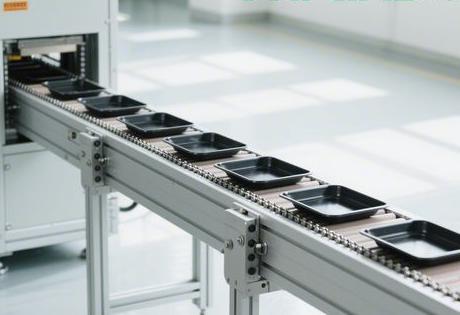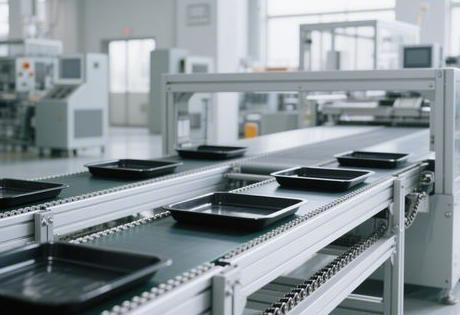In the vein of modern industrial production.Ring Roller Doubling Chain LineIt is quietly reconfiguring the boundaries of productivity. It is not only the carrier of material transport, but also through theMechanical precision designtogether withintelligent controlThe integration of the production of the production of the beat of the free control, become the core infrastructure of flexible production in the field of electronics, automotive, new energy and other fields.

I. The Mechanical Mystery of Multiplier Chain: Principle of Speed Increase and Structural Innovation
The multiplier chain is named after its uniquePhysical growth rate mechanism--When the chain is running at a constant speed (v₀), the actual speed (v) at which the work plate is moving can be up to 2-3 times the speed of the chain. The core formula for this is:
v = (1 + D/d) × v₀
(D is roller diameter, d is roller diameter)
This growth rate is achieved through the synergy of three sets of precision components:
- growth rate unit (computing): The difference between the roller diameter (D) and the roller diameter (d) forms the basis for speed multiplication, and the D/d ratio is usually designed to be 1.5-2.5.
- load-bearing structure: Tandem assembly of inner/outer chain plates and pins, where the pins and the inner chain plates are clearance fitted to ensure flexible chain bending.
- Material InnovationEngineering plastic rollers (e.g. nylon) are used in light load scenarios, while steel rollers are used in heavy load environments, with a single point load capacity of up to 250kg.
In a circular layout, theClosed-loop guideway designZero-empty cycle is achieved for the tooling board. Taking the automotive parts production line as an example, the tooling board automatically turns over the line and returns to the starting point through the lifting and transplanting mechanism within 5 seconds after completing the assembly, and the space utilisation rate is increased by 40%.
Second, the engineering advantages of the ring layout: beyond the traditional conveying line of technological breakthroughs
Compared with traditional linear conveying, the ring speed multiplier chain highlights the triple competitiveness:
1. Space and process re-engineering
▸ Closed-loop topology reduces end-reserve space and increases capacity per unit area by 2.8x
▸ Vertical tiering design supports three tiers of conveying, adapting to constrained sites in old factory renovations
2. Dynamic beat control

"The blocker is realised in conjunction with the PLCFree Beat Management-Operator footswitch to pause localised job boards while the whole line continues to run, reducing efficiency fluctuations from 22% to less than 5%"
3. Extreme environmental resilience
- High-temperature scenario: ceramic-coated rollers with a temperature resistance of 1200°C (aluminium ingot conveying line)
- Cleanliness requirements: stainless steel chain + seamless guide rail HACCP certified (food factories)
- Anti-corrosion solution: nickel-plated chain plates salt spray test >720 hours (chemical workshop)
III. Multi-industry penetration and application innovation
1. Automotive manufacturing: heavy-duty precision transport
In the assembly of new energy battery packs, the ring doubler chain carries 500kg battery packs through theDual redundant chain designAchieve 0.5 second failover:

- Welding station: high-temperature resistant chain with liquid-cooled guide rail (temperature control ±5℃)
- Inspection station: RFID chip embedded in the chain plate to track process parameters in real time.
2. Electronics industry: micro-precision assembly
On the optical lens assembly line, the circular layout is coupled with a three-point advantage:
- Sub-millimetre positioning: Blocker + travel switch control error ≤±0.1mm
- Anti-static work plate: surface resistance 10⁶-10⁹Ω, to avoid component breakdown
- Modular expansion: 20% power margin reserved to support future line additions
3. Agro-processing: flexible sorting systems
Kiwifruit sorting line with waterproof multiplier chain, integrating two innovations:
- Self-cleaning nozzles: water jet in the gap between the chain plates, reducing water consumption 55%
- Dynamic Sorting: Photoelectric Sensor + AI Algorithm Achieves 0.3 Seconds Rejection of Defective Fruits
IV. Key design elements: technical logic from theory to implementation
Parameter Matching Matrix
| Parameter type | Light-duty line (electronic) | Heavy-duty lines (automotive) |
|---|---|---|
| octave ratio | 3x speed | 2.5x speed |
| Chain material | engineering plastics | Alloy steel quenching |
| Workpiece plate load-bearing | ≤80kg/m | ≤250kg/m |
| turning radius | R300mm | R1200mm |
Cost Control Strategy
- Preventive maintenance: Engineering plastic rollers 8000 hours mandatory replacement to avoid sudden stoppages
- Oversize Selection: Selection of motor according to 2200kg when the current load is 1800kg, reducing the cost of later modification.
V. Maintenance strategy and performance optimisation: full life-cycle management
Based on dust, high humidity and other industrial scenarios, Guangyuan Enterprises innovates triple protection:
- Chain handling: Ceramic layer formed by micro-arc oxidation, hardness up to HV800
- Roller upgrade: PA66+30% glass fibre injection moulding, humidity resistant RH95%
- Joint protection: Food-grade silicone fills gaps and blocks corrosive media
Comparison of effectiveness data reveals economics:
plaintextmake a copy of+-------------------+--------------+-------------------+ | Indicators | Conventional Drum Lines | Ring Doubling Chain System | +-------------------+--------------+-------------------+ | Unit energy consumption (kWh/tonne) | 7.2 | 4.8 (-33%) | | Failure interval (hours) | 320 | 1,150 (+259%) | | Changeover Adjustment Time | 6 hours | 45 minutes (-87.5%) | +-------------------+--------------+-------------------+
VI. Intelligent upgrading: from the transmission chain to the data neural net
Modern multiplier chain systems are undergoing a threefold evolution:
1. Extension of the perceptual layer
- Tension sensor monitors chain deformation in real time, warning deviation >2%
- Current fluctuation analysis predicts roller life with an accuracy of 92%
2. Innovations in energy recovery
Regenerative braking system converts deceleration kinetic energy into electrical energy, with a recycling efficiency of 74%, saving more than $150,000 in annual electricity costs (based on a 24-hour production line).
3. Digital twin integration
Case study of an automotive company: virtual model synchronised to optimise physical line beats, downtime reduced by 761 TP3T, OEE (Overall Equipment Effectiveness) exceeded 921 TP3T
Self-questioning: a breakdown of the core issues
Q1: Why is a circular layout more space efficient than a linear one?
A: Elimination of end idle zones in linear production lines through closed loop, combined with vertical lifting to achieve three levels of conveying.Reduced footprint 35%-40%It is particularly suitable for compact plants in urban industrial parks.
Q2: Why does the work plate need to be used with the blocker?
A: Blocker realisationDynamic Accumulation FunctionThis allows a continuously running chain to pause for localised workpieces as required by the station. For example, in an automotive assembly line, where the engine mounting station takes a long time and the screw fastening station takes a short time, free-running beats ensure that the processes are balanced.
Q3: Which industries have the highest priority to introduce this system?
A.Automotive parts and components(heavy-duty HF).3C electronics(micro-accuracy required).fresh processing(Health standards) Three major areas have the most significant benefits. New energy battery assembly has become a new growth point, 2025 market size is expected to exceed 8 billion yuan.













